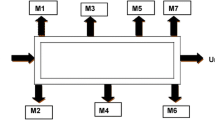Abstract
In this paper, we evaluate two types of flexibility, machine flexibility and routing flexibility, in terms of manufacturing performance in various shop environments. A simulation-based investigation was conducted to analyze the impact of these types of flexibility on the average flow time of parts under various job flow pattern conditions, which characterize the shop nature from a random job shop to a flow shop, operation time variance, setup time, and shop load. The experimental results show how these types of flexibility affect the average flow time of parts and which type is superior under what conditions. Management can obtain better insight and guidelines for determining priorities or the scale, or scope, of various decision items relating to design standardization, process and operations improvement, investment in new equipment and tools, and the like.
Similar content being viewed by others
References
Benjaafar, S., “Models for Performance Evaluation of Flexibility,” International Journal of Production Research, Vol. 32, No. 6, pp. 1383-1402 (1994).
Benjaafar, S., Morin, T.L., and Talavage, J.J., “Strategic Value of Flexibility in Sequential Decision Making,” European Journal of Operational Research, Vol. 82, No. 3, pp. 438-457 (1995).
Benjaafa, S. and Ramakrishnan, R., “Modelling, Measurement and Evaluation of Sequencing Flexibility in Manufacturing System,” International Journal of Production Research, Vol. 34, No. 5, pp. 1195-1220 (1996).
Brill, P.H. and Mandelbum, M., “One Measure of Flexibility in Manufacturing Systems,” International Journal of Production Research, Vol. 27, No. 5, pp. 747-756 (1989).
Brill, P.H. and Mandelbum, M., “Measurement of Adaptivity and Flexibility in Production Systems,” European Journal of Operational Research, Vol. 49, No. 3, pp. 325-340 (1990).
Browne, J., Dubois, D., Rathmill, K., Sethi, S.P., and Stecke, K.E., “Classification of Flexible Manufacturing Systems,” The FMS Magazine, pp. 114-117 (April 1984).
Chandra, P. and Tombak, M., “Models for the Evaluation of Routing and Machine Flexibility,” European Journal of Operational Research, Vol. 60, No. 2, pp. 156-165 (1992).
Das, S.K. and Nagendra, P., “Investigations into the Impact of Flexibility on Manufacturing Performance,” International Journal of Production Research, Vol. 31, No. 10, pp. 2337-2354 (1993).
Ghosh, S. and Gaimon, C., “Routing Flexibility and Production Scheduling in a Flexible Manufacturing System,” European Journal of Operational Research, Vol. 60, No. 3, pp. 344-364 (1992).
Hyun, J.H. and Ahn, B.H., “A Unifying Framework for Manufacturing Flexibility,” Manufacturing Perspective, Vol. 5, No. 4, pp. 251-260 (1993).
Mahmoodi, F., Tierney, E.J., and Mosier, C.T., “Dynamic Group Scheduling Heuristics in a Flow-through Cell Environment,” Decision Sciences, Vol. 23, No. 4, pp. 61-85 (1992).
Park, P.S., “The Examination of Worker Cross-Training in a Dual Resource Constrained Job Shop,” European Journal of Operational Research, Vol. 52, No. 3, pp. 291-299 (1991).
Philipoom, P.R. and Fry, T.D., “Capacity-Based Order Review/Release Strategies to Improve Manufacturing Performance,” International Journal of Production Research, Vol. 30, No. 11, pp. 2559-2572 (1993).
Sethi, A.K. and Sethi, S.P., “Flexibility in Manufacturing—A Survey,” International Journal of Flexible Manufacturing Systems, Vol. 2, No. 4, pp. 289-328 (1990).
Tsubone, H. and Matsuura, H., “On the Flexibility of the Production System,” JIMA, Vol. 46, No. 1, pp. 1-12 (1995).
Wemmerlöv, U., “Fundamental Insights into Part Family Scheduling,” Decision Sciences, Vol. 23, No. 3, pp. 565-595 (1992).
Yao, D.D. and Pei, F., “Flexible Parts Routing in Manufacturing Systems,” IIE Transactions, Vol. 22, No. 1, pp. 48-55 (1990).
Author information
Authors and Affiliations
Rights and permissions
About this article
Cite this article
Tsubone, H., Horikawa, M. A Comparison Between Machine Flexibility and Routing Flexibility. International Journal of Flexible Manufacturing Systems 11, 83–101 (1999). https://doi.org/10.1023/A:1008096724273
Issue Date:
DOI: https://doi.org/10.1023/A:1008096724273




